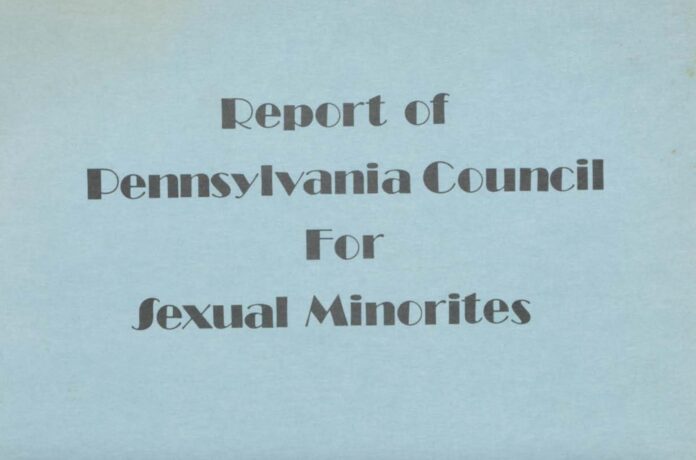A new digital archive of Central PA LGBTQ history is now available as part of a collaboration between Dickinson College’s Archives and Special Collections and the LGBT Center of Central PA.
“We have spent about 10 years collecting an amazing array of material that documents this history and we want to share it with everyone who is interested in seeing it. Now this digitization initiative has made that possible,” Barry Loveland, chair of the LGBT History Project, said in a press release.
The archive provides digital access to items detailing the work of individuals and organizations including Rural PA Gay Caucus, Pink Triangle Coalition, Metropolitan Community Church, and publications including Gay Era and Lavender Letter.
Among the collection are photographs of early gay rights demonstrations, newsletters and events listings, items from historic LGBTQ bars and restaurants, meeting minutes from LGBTQ organizations, and interview transcripts with LGBTQ activists.
Many of the artifacts in the collection provide insights into the fight for equality in the ‘70s that are relevant today. In March 1977, the Pennsylvania Council for Sexual Minorities sent its first annual report to Governor Milton Shapp about its work to end discrimination against sexual minorities and educate people on the problems the community faced.
“Although 1976 has been a productive year for us,” chairperson Tony Silvestre wrote in the introduction, “we have just begun to address the relevant issues. With your support, and the dedication of human rights organizations and people throughout the Commonwealth, 1977 will prove even more fruitful and, we hope, will lead ultimately to full equality for every citizen of Pennsylvania.”
The crux of the work done by the council in 1976 involved making connections with, meeting with, and educating government employees, legislators, and unions. In some cases, it was the first time many of those individuals had met or spoken with LGBTQ people, since the community was still invisible in many parts of the state. That first year, members of the council appeared on over fifteen radio and television programs across the state to talk about LGBTQ issues.
One vital resource that the council immediatley provided was an avenue for people to file complaints of discrimination due to being a sexual minority.
“Members of sexual minorities have traditionally experienced discrimination in employment, health services, insurance, housing, law enforcement, and other areas,” the report reads. “In the past, people who have suffered such discrimination have had no recourse or avenue for appeal. Since the establishment of the Council, however, citizens have been able to report discrimination to the Council’s Complaint Center and gain help in resolving their problems.”
However, many issues — which continue to this day — persisted with proving discrimination due to a person’s LGBTQ status. Oftentimes employers would cite other, exaggerated reasons for disciplining or firing an employee, and those who were wronged were often afraid to make their complaints public for fear of outing themselves to friends or family. The council’s recommendations to remedy those issues included working with state agencies and private enterprises to educate them on the new rules, as well as keeping discrimination cases as confidential as possible.
One industry which saw numerous employees being discriminated against or fired was education. The council’s education committee, in its section of the report, highlighted their support for a sexual preference clause in collective bargaining agreements, their work with universities including Temple and Penn State to help resolve individual problems on those campuses, and their outreach to a publishing company to shed light on the “inaccuracy of its printed material on sexual minorities.” But perhaps the most important work of the committee that year was getting approval to educate school staff members on sexual minorities and to increase sensitivity and responsibilty to the rights of sexual minorities.
Similar efforts to spread visibility and sensitivity also occurred in the halls of the state Capitol building. The council’s legislation committee helped bring 100 people from all parts of the state to Harrisburg to speak with legislators about equal rights for sexual minorities. The visitors also lobbied for House Bill 2220, which “proposed expanding the Pennsylvania Human Relations Act to prohibit discrimination based on ”sexual or affectional preference.” The legislation committee also highlighted its work to repeal Pennsylvania’s sodomy statute (which was ultimately repealed in 1980.)
The council’s health committee highlighted its work to survey the health concerns of LGBTQ people and help healthcare providers to better care for LGBTQ patients. Dr. Walter Lear, who represented the PA Secretary of Health on the council, helped facilitate three scientific sessions at that year’s meeting of the American Public Health Association. It was the first time openly gay health workers presented papers on the health concerns of gay people at a major national health meeting.
In addition to education, legislation, and health, another committee on the Council for Sexual Minorities was the “Special Minority Concerns Task Force.” In their section of the report, the Task Force highlighted a fact that still looms large today: people are not as educated about the trans community as they are about the gay and lesbian community, and this often leads to greater discrimination of trans people than LGB people.
“There is much confusion about the interrelationships and distinctions among sexual minority groups,” the Task Force wrote. “In many ways, general consciousness of these “other” minorities is today at the point where consciousness of gays was several years ago. Thus, the task force’s main objectives are to disseminate information, address prejudice, and sensitize people — especially those in positions of power.”
The entire 1977 report from the Pennsylvania Council for Sexual Minorities highlights the cyclical nature of discrimination and the activism to combat it. It, along with all the items in the digital collection, showcase how the LGBTQ community grew both in number and in visibility. And it reveals that many of the tactics used then are still relevant today, including, and especially, making connections locally and connecting with people one-on-one.
